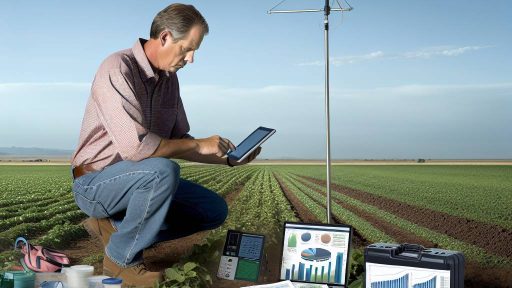Understanding the Importance of Budgeting in Farming Operations
Budgeting plays a crucial role in the success of farming operations.
Proper financial management allows farmers to allocate resources effectively.
It helps in understanding the cash flow dynamics within a farm.
Additionally, budgeting aids in planning for seasonal expenses.
Farmers can identify potential financial risks through diligent budgeting.
By planning ahead, operators can enhance their decision-making processes.
Resource Allocation
Effective budgeting enables farmers to prioritize their resources.
They can distribute funds to key areas that require attention.
This distribution maximizes productivity and sustainability.
Resource allocation involves assessing both short-term and long-term needs.
Farmers can invest in equipment, seeds, and technology based on budget insights.
Cash Flow Management
Strong cash flow management is essential for farm viability.
Budgeting allows farmers to anticipate revenue and expenditures.
This anticipation aids in maintaining liquidity throughout the year.
Farmers can avoid financial crises by monitoring cash flow closely.
Transform Your Agribusiness
Unlock your farm's potential with expert advice tailored to your needs. Get actionable steps that drive real results.
Get StartedFurther, they can make informed decisions about borrowing or investing.
Financial Risk Mitigation
Budgeting provides a framework for understanding financial risks.
Farmers can identify variabilities in income caused by market fluctuations.
Effective strategies can be developed to mitigate these risks.
This preparedness enhances a farm’s resilience to unexpected changes.
Farmers who budget successfully often have contingency plans in place.
Informed Decision-Making
Budgeting equips farmers with vital information for decision-making.
They can evaluate the cost-to-benefit ratio of different practices.
Such evaluations lead to more strategic investments in the farm.
Additionally, it encourages farmers to set clear financial goals.
This clarity enhances both operational efficiency and profitability.
Identifying Key Financial Components
Understanding Income Sources
Farms generate income from various sources.
Primary income typically comes from crop and livestock sales.
Additionally, off-farm income can bolster financial stability.
Investments in agritourism present another potential revenue stream.
Therefore, monitoring income trends is essential for planning.
Assessing Costs Effectively
Farm expenses can be categorized into fixed and variable costs.
Fixed costs include land rent, mortgages, and insurance payments.
Variable costs cover seeds, fertilizers, and labor expenses.
Understanding each cost component aids in efficient budget planning.
Moreover, keeping track of changes in costs helps identify savings opportunities.
Evaluating Investments
Investments can significantly impact a farm’s long-term profitability.
Common investments include equipment, technology, and infrastructure.
These investments should align with the farm’s strategic goals.
Showcase Your Farming Business
Publish your professional farming services profile on our blog for a one-time fee of $200 and reach a dedicated audience of farmers and agribusiness owners.
Publish Your ProfileAdditionally, periodic reviews of investment performance guide future decisions.
Ultimately, successful investment evaluation requires careful analysis.
Integrating Financial Components for Success
Combining income, costs, and investments is crucial for overall management.
This integration supports informed decision-making throughout the year.
Regular financial reviews can highlight areas needing attention.
Ultimately, effective budgeting leads to a sustainable farming operation.
Setting Clear Financial Goals
Importance of Financial Goals
Financial goals provide direction and clarity for your farming operations.
They help prioritize spending and investments effectively.
Furthermore, they offer a benchmark for measuring progress.
Short-term Objectives
Short-term objectives typically span one year or less.
These goals often focus on immediate cash flow needs.
For example, farmers may aim to pay off short-term debts.
Another goal could include purchasing necessary supplies.
Additionally, tracking monthly expenses can enhance financial control.
- Clearing outstanding feed bills by harvest time.
- Increasing monthly savings by a set percentage.
- Upgrading equipment to improve efficiency.
Long-term Objectives
Long-term objectives usually extend beyond one year.
These goals focus on sustainable growth and future planning.
They often include expanding operations or increasing land ownership.
Moreover, developing a retirement plan is crucial for long-term security.
- Acquiring additional farmland within the next five years.
- Saving for a college education for children or successors.
- Investing in renewable energy sources for the farm.
Aligning Short-term and Long-term Goals
It is essential to align short-term objectives with long-term goals.
This alignment ensures resources are utilized efficiently.
Moreover, regular evaluations can help adjust goals as needed.
Strategies for Alignment
- Review short-term spending regularly to support long-term investments.
- Set milestones for long-term goals to motivate short-term actions.
- Create a budget that reflects both short-term and long-term priorities.
Delve into the Subject: Marketing Strategies For Successful Agritourism Businesses
Creating a Comprehensive Budgeting Template for Farm Management
Identifying Financial Objectives
Define your short-term and long-term financial goals.
Your budget should align with these objectives.
Begin by assessing past financial performance.
Analyze revenue sources and expense categories.
This foundation helps set realistic targets.
Gathering Necessary Financial Data
Collect all relevant financial information.
Include income statements, balance sheets, and cash flow statements.
This data provides an overview of your financial health.
Ensure accuracy in the information you compile.
Using accounting software can simplify this process.
Structuring the Budgeting Template
Create a clear layout for your budgeting template.
Divide it into income and expense sections.
List all revenue sources under income.
- Crops sold
- Livestock sales
- Grants and subsidies
Next, categorize expenses into fixed and variable costs.
- Rent or mortgage payments
- Utilities and supplies
- Labor costs
Implementing a Review and Adjustment Process
Regularly review the budgeting template.
Compare actual performance against budgeted amounts.
Adjust estimates based on seasonal changes and market trends.
This process keeps the budget relevant and effective.
Showcase Your Farming Business
Publish your professional farming services profile on our blog for a one-time fee of $200 and reach a dedicated audience of farmers and agribusiness owners.
Publish Your ProfileConsider monthly or quarterly reviews for best results.
Utilizing Technology Tools
Incorporate budgeting software into your management practices.
These tools can enhance accuracy and efficiency.
Many programs offer customizable templates specific to farming.
Additionally, they can track changes in real-time.
This feature helps make informed financial decisions.
See Related Content: Precision Agriculture Tools To Reduce Operational Costs
Utilizing Technology and Software for Accurate Financial Tracking
The Importance of Financial Tracking
Accurate financial tracking is essential for any successful farm operation.
It allows farmers to understand their financial health over time.
Moreover, it helps in making informed budgeting decisions.
Effective tracking minimizes discrepancies and reduces stress during audits.
Choosing the Right Software
Farmers should identify software that meets their specific needs.
Consider platforms that offer intuitive interfaces and strong support.
Research tools designed specifically for agricultural operations.
- Look for software that integrates with other systems.
- Prioritize mobile-friendly applications for on-the-go access.
- Evaluate options that provide real-time data analytics.
Implementing Financial Tracking Systems
Set up a systematic approach to financial data entry.
Regularly update your income and expense records.
Utilize cloud-based systems for better data accessibility.
Encourage team members to enter data consistently.
This ensures that all information remains up-to-date and accurate.
Analyzing Financial Data
Use software analytics features to assess financial performance.
Identify trends and anomalies in expenses and revenues.
Regular analysis can uncover potential cost-saving opportunities.
Additionally, it aids in setting realistic financial goals.
Training and Support
Provide training for team members on financial software usage.
Support is crucial for successful implementation and utilization.
Consider inviting technology experts for workshops.
Incorporate regular feedback sessions to address concerns.
Staying Up-to-Date with Technology
Technology in agriculture is constantly evolving.
Stay informed about the latest software updates and features.
Evaluate new tools to improve financial tracking capabilities.
Regular adjustments ensure your financial management remains efficient.
Find Out More: Sustainable Diversification Methods for Contemporary Farmers
Implementing Seasonal Budgeting Strategies to Manage Cash Flow
Understanding Seasonal Variations
Agricultural cash flow fluctuates throughout the year.
These fluctuations directly relate to harvest cycles and planting schedules.
Understanding these seasonal patterns helps farmers anticipate needs.
Creating a Seasonal Budget
Start by reviewing historical income and expenses.
This analysis provides insights into predictable cash flow patterns.
Next, categorize expenses and income by season.
Also, consider factors like weather and market conditions.
Using this data, create realistic budget estimates for each season.
Showcase Your Farming Business
Publish your professional farming services profile on our blog for a one-time fee of $200 and reach a dedicated audience of farmers and agribusiness owners.
Publish Your ProfileTracking and Adjusting Your Budget
Regularly track actual income and expenses against your budget.
This tracking helps identify discrepancies early.
When necessary, adjust your budget to reflect actual conditions.
For example, if crop yields are lower than expected, modify your spending accordingly.
Utilizing Technology for Budget Management
Technology plays a vital role in effective budgeting.
Use financial software to streamline your budgeting process.
This software can automate tracking and reporting functions.
Moreover, many tools provide insights and forecasts for better decision-making.
Engaging with Financial Advisors
Consider involving a financial advisor in your budgeting process.
A professional can offer valuable perspectives on financial management.
They help identify potential pitfalls and areas for improvement.
Additionally, they can provide resources for more effective budgeting strategies.
Delve into the Subject: Creating Memorable Farm Stays To Boost Agritourism Appeal

Monitoring and Adjusting Budgets
Importance of Regular Reviews
Regular budget reviews are key for effective financial management.
Farmers should evaluate their budgets periodically to maintain financial health.
This practice helps identify any discrepancies between estimated and actual expenses.
Moreover, it allows for timely adjustments to stay on track.
Benefits of Frequent Reviews
Frequent reviews promote accountability among farm managers.
When managers are accountable, they make more informed decisions.
This leads to better resource allocation across the farm.
Additionally, regular assessments can highlight areas needing improvement.
Consequently, farmers can adapt their strategies to changing conditions.
Methods for Effective Monitoring
Use accounting software to track expenses and income easily.
This software can generate reports that simplify the review process.
Implementing a calendar for budget reviews helps maintain consistency.
Furthermore, consider engaging financial advisors for expert insights.
Adjustments Based on Market Trends
Market trends can greatly impact a farm’s budget allocations.
Staying informed about these trends enables better financial planning.
Adjust budgets to reflect rising costs or changes in crop markets.
This proactive approach can safeguard against unexpected losses.
Creating a Feedback Loop
A feedback loop fosters continuous improvement in budgeting.
After each review, document lessons learned and insights gained.
Share this information with the farm team to enhance collaboration.
A cohesive team can contribute diverse ideas for budget adjustments.
Ultimately, robust feedback mechanisms increase the farm’s financial resilience.
Leveraging Financial Ratios and Indicators for Better Decision Making
Understanding Financial Ratios
Financial ratios provide key insights into farm performance.
They help farmers evaluate profitability, liquidity, and efficiency.
For instance, the current ratio shows how well a farm can pay its short-term liabilities.
Conversely, the debt-to-equity ratio indicates financial leverage and risk.
By analyzing these ratios, farmers can make informed decisions.
Showcase Your Farming Business
Publish your professional farming services profile on our blog for a one-time fee of $200 and reach a dedicated audience of farmers and agribusiness owners.
Publish Your ProfileKey Financial Indicators
Important financial indicators include gross profit margin and return on assets.
The gross profit margin reflects the percentage of revenue exceeding the cost of goods sold.
A higher gross profit margin suggests efficient cost management.
Return on assets measures how effectively a farm utilizes its resources.
Optimizing this ratio can enhance overall farm productivity.
Utilizing Ratios for Benchmarking
Farmers can use financial ratios for benchmarking against industry standards.
This process highlights areas needing improvement.
For example, if profitability ratios lag behind peers, investigating costs may be necessary.
Benchmarking provides a framework for setting performance goals.
Continuous monitoring ensures farms remain competitive.
Making Strategic Decisions
With clear financial data, farmers can make more strategic decisions.
For instance, understanding cash flow helps in planning for seasonal expenses.
Additionally, comparing historical financial ratios aids in tracking improvements over time.
Effective decision making relies on regular financial reviews and adjustments.
Implementing these insights can drive sustainable growth in farm operations.
Exploring Funding Options
Loans for Farmers
Farmers can secure loans through various institutions.
Commercial banks often provide options tailored for agriculture.
Additionally, the U.S. Department of Agriculture offers specific loans for farmers.
These loans help purchase equipment and expand operations.
Farmers should compare interest rates and repayment terms.
This comparison ensures the best financial decision.
Grants for Agricultural Projects
Various organizations offer grants for farming projects.
These grants do not require repayment, making them attractive.
Research federal and state grant opportunities for farming initiatives.
Non-profit organizations also provide funding for sustainable practices.
Farmers should prepare detailed project proposals to increase chances of approval.
Alternative Funding Sources
In addition to loans and grants, farmers can explore alternative funding options.
Crowdfunding has gained traction for agricultural projects.
Platforms like Kickstarter allow farmers to present their ideas to the public.
Investors may support innovative agricultural ventures through equity funding.
Partnerships with local businesses can also provide necessary resources.
Understanding Financial Requirements
A comprehensive understanding of funding requirements is crucial.
Farmers must assess their financial needs before seeking funding.
This assessment should include potential expenses and revenue forecasts.
Knowing the specific use of funds strengthens funding applications.
Transparently communicating these details can attract more financial support.
Additional Resources
Risk Management – Risk in Agriculture | Economic Research Service




